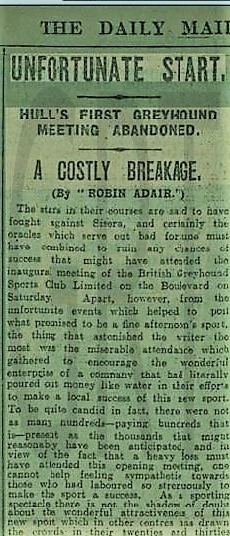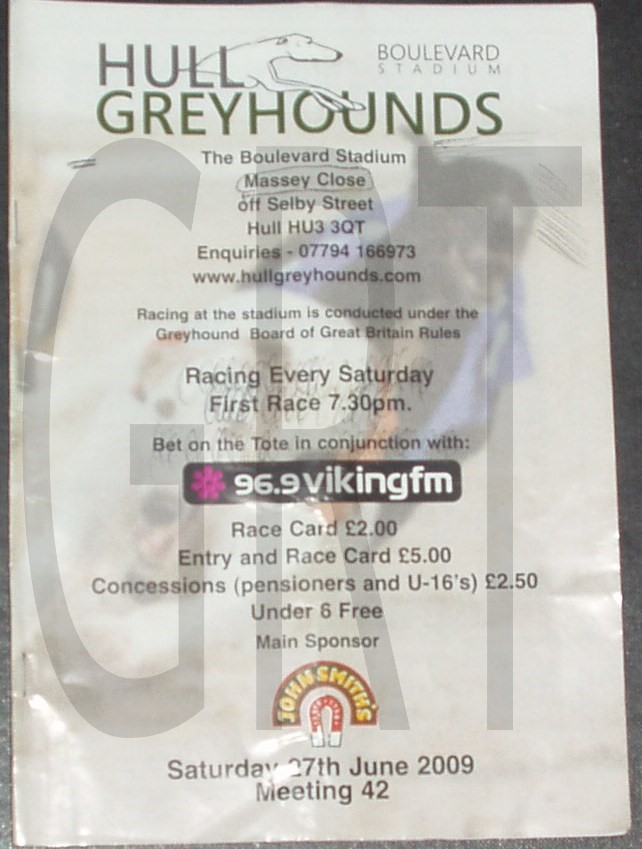The Boulevard Stadium, Airlie Street, Hull, Humberside.
POSTCODE———————————–HU3 3QT
LOCATED————————————-About one mile west of Hull city centre, and just half a mile south of the New Community Stadium.
ORIGINAL SITE——————————Originally an athletics track.
DATE CONSTRUCTED———————Early 1890’s
DATE VENUE OPENED——————-1895 for Rugby League.
Meaning other sports may have taken place prior to the arrival of Greyhound Racing.
FIRST MEETING—————————–July 2nd 1927. Had periods of closures / re-openings as detailed in the comments.
Greyhound Racing only.
LICENSED OR INDEPENDENT———-NGRC.
All venues covered would have to be licensed with the government, licensed suggested in this section would refer to tracks operating under NGRC Rules.
INSIDE OR OUTSIDE HARE TYPE——Outside Fannon Swaffham.
Please note that the Electric Hare suggested is only a guidance, and would have been in operation for a certain amount of time at this venue. Although it is not necessarily guaranteed that it was operational all the time, as other types of lure may have been used and updated as time progressed.
DISTANCES———————————–270, 464 and 662 metres.
Please note that most racing venues distances had become varied throughout the years, the ones given above were at once point set and offers only a guidance to the track size.
CIRCUMFERENCE—————————387 metres.
Please note that alterations at most racing venues throughout its existence would see that the circumference of the track would vary, the one shown above offers only a guidance to the track size.
BIG RACE NAMES—————————Hull Derby.
STADIUM SHARED WITH——————Hull Rugby League Club.
LAST MEETING——————————-June 27th 2009.
Greyhound Racing only.
STADIUM CLOSURE DATE—————-June 27th 2009.
Meaning other sports may have taken place after Greyhound Racing had ceased.
STADIUM DEMOLITION——————-August 2010.
BUILT ON SITE——————————–A modern school known as The Boulevard Academy.
In some cases, structure’s that originally covered the venue after the stadium had been demolished, may have been themselves demolished too, so the one described is more likely to be the one which now presently covers the site.
EVIDENCE LEFT TODAY——————–Dont know.
FURTHER COMMENTS———————Originally known as the Athletics Ground. Closed due to concerns regarding spectator safety.











Hull’s Boulevard, had its name nationally linked with Hull Rugby League Club, yet unknown to many it also became the first of four venues that would stage Greyhound Racing in the Humberside City. The venue was located one mile east of the city centre, and throughout its history had been the home to a number of different sports.
It was during 1890 that the first signs of sporting activities took place, with athletics meetings featuring regularly, but by 1892 Hull Kingston Rovers, a newly formed Rugby League club began staging home matches there, and would continue to do so for the next three seasons before eventually moving on to play at another venue elsewhere in the city. By 1895 another newly formed Rugby League club known as Hull FC. began playing matches there, but this time the club would settle there permanently and make it their home for the next hundred years or so.
Although originally known as The Athletics Ground, The Boulevard picked up its title acting as a Rugby League venue, even though the oval shape as an athletics venue was always evident throughout its existence. With athletics and rugby league already on its list of sports, professional football would be the next sport to feature with tenants Hull City using the venue between 1905 and 1908, well before the first greyhound race, which would eventually take place during 1927.
The arrival of greyhound racing had been financially backed by The Associated Greyhound Racecourses, or The AGR as it was known then, a company not to be confused with the GRA, who themselves was involved with promoting the sport in other towns and cities across the UK. It was during the spring of 1927, that a circuit was laid around the rugby pitch, along with the construction of large kennel block in the stadium grounds that would become the home to scores of company owned greyhounds.
On the 2nd of July 1927, The Boulevard staged its first meeting, with races run under rules similar to those of the NGRC, an organisation who would eventually form twelve months later. Unfortunately, the first meeting began as a disaster, with the electric hare breaking down after only a few races, causing the meeting to be abandoned. Once the management had overcame its teething problems, greyhound racing began to feature as many as five meetings per week. The success of the sport was evident due to the large crowds that gathered, but the introduction of new betting legislation in 1934, which reduced meetings to 104 per year, strongly affected the tracks income, which in turn forced The Greyhound Company to close the track. But within weeks of its closure, a new greyhound company stepped in to take control and by the end of 1934, greyhound racing was back in action at The Boulevard.
The Boulevard continued to host Rugby League matches throughout the years, and had set a record attendance of 28,798 in 1936, when Hull RLFC played Leeds in a Challenge Cup Match. The outbreak of The Second World War became testing times for the venue, after witnessing The East Stand suffer serious bomb damage during an air raid in 1941. Having survived the hostilities, Greyhound Racing ceased at the venue in December 1948, the reason being that heavy government taxation had made it financially impossible to make a profit.
Greyhound Racing did not feature again until the late 1960’s, but these were only a handful of temporary meetings, with the temporary track removed after each meeting. During 1971 The Boulevard added another sport to its list, this time with the arrival of Speedway Racing, a sport that would be linked to the venue for the next ten seasons. Speedway ceased due to the promoters having been refused permission to continue due to complaints from the rugby club regarding shale constantly covering the surface of the rugby pitch, and also their poor co-operation regarding improvements to the drainage of the speedway track. In October 2002, The Hull Rugby League Club moved in to the brand new Community Stadium, situated on the West side of the city, leaving The Boulevard virtually unused apart from training purposes and reserve fixtures.
It was during this period that The Craven Park Greyhound Company approached The Council to switch Greyhound Racing from the New Craven Park to The Boulevard. Their reasons were that the greyhound company was struggling financially, due to the landlord reaping the benefits made from the restaurants and bar takings during race meetings, and also continuous problems with the outside hare drive motor.
By November 2003 Greyhound Racing was back once again at The Boulevard, for a period that would last for the next 28 months, before racing was suspended in March 2006, this due to the sacking of the tracks promoter, leaving the greyhound racing company with no license to operate. The future of The Boulevard was clearly in doubt, after it was announced that it was on the verge of being demolished, but another reprieve came during 2007, after another greyhound company approached the council with a view of staging Greyhound Racing once again in the city. The stadium became totally revamped with the track and its facilities upgraded, along with the construction of a brand new restaurant, at a total cost of £250,000.
Its first meeting came on the 25th of October 2007, staging race meetings under NGRC rules. Its big attraction was The Hull Derby, and ran distances of 270,464 and 662 metres, with the greyhounds chasing an outside Fannon Swaffham type hare. Unfortunately, poor attendances and limited numbers of greyhounds available had seen the track struggle to stage two meetings per week, and with income way short of expectation the track was running at a loss. The poor financial return and lack of interest certainly contributed to the tracks closure, with a final meeting being staged on the 27th of June 2009.
An inspection from council officials during the Summer of 2010, raised serious concerns regarding safety, and enforced a ban on all sporting activities at the venue. Sadly, the inspection report had not only condemned the stadium, but requested it should be demolished as soon as possible. Demolition began in August 2010, and within three years, a new training school known as The Boulevard Academy covered the site. This large construction and its ground is situated along Massey Close, and now acts as a pointer to were the old site used to be.

Recent Comments